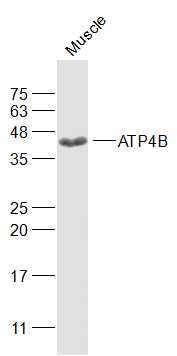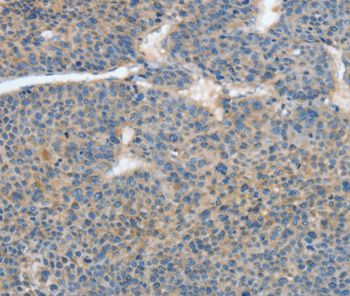![IHC-P analysis of human gastric carcinoma tissue using GTX22866 Hydrogen Potassium ATPase Beta antibody [2G11]. Left : Primary antibody Right : Negative control without primary antibody Antigen retrieval : heat induced antigen retrieval was performed using 10mM sodium citrate (pH6.0) buffer, microwaved for 8-15 minutes Dilution : 1:200 IHC-P analysis of human gastric carcinoma tissue using GTX22866 Hydrogen Potassium ATPase Beta antibody [2G11]. Left : Primary antibody Right : Negative control without primary antibody Antigen retrieval : heat induced antigen retrieval was performed using 10mM sodium citrate (pH6.0) buffer, microwaved for 8-15 minutes Dilution : 1:200](https://www.genetex.com/upload/website/prouct_img/normal/GTX22866/GTX22866_1181_IHC-P_w_23060620_224.webp)
IHC-P analysis of human gastric carcinoma tissue using GTX22866 Hydrogen Potassium ATPase Beta antibody [2G11]. Left : Primary antibody Right : Negative control without primary antibody Antigen retrieval : heat induced antigen retrieval was performed using 10mM sodium citrate (pH6.0) buffer, microwaved for 8-15 minutes Dilution : 1:200
Hydrogen Potassium ATPase Beta antibody [2G11]
GTX22866
ApplicationsFlow Cytometry, ImmunoFluorescence, ImmunoPrecipitation, Western Blot, ChIP Chromatin ImmunoPrecipitation, ImmunoCytoChemistry, ImmunoHistoChemistry, ImmunoHistoChemistry Frozen, ImmunoHistoChemistry Paraffin
Product group Antibodies
TargetATP4B
Overview
- SupplierGeneTex
- Product NameHydrogen Potassium ATPase Beta antibody [2G11]
- Delivery Days Customer9
- Application Supplier NoteWB: 1:4,000. ICC/IF: 1:2,000. IHC-P: 1:2000. IHC-Fr: 1:2000. FACS: 1/50. *Optimal dilutions/concentrations should be determined by the researcher.Not tested in other applications.
- ApplicationsFlow Cytometry, ImmunoFluorescence, ImmunoPrecipitation, Western Blot, ChIP Chromatin ImmunoPrecipitation, ImmunoCytoChemistry, ImmunoHistoChemistry, ImmunoHistoChemistry Frozen, ImmunoHistoChemistry Paraffin
- CertificationResearch Use Only
- ClonalityMonoclonal
- Clone ID2G11
- ConjugateUnconjugated
- Gene ID496
- Target nameATP4B
- Target descriptionATPase H+/K+ transporting subunit beta
- Target synonymsATP6B, potassium-transporting ATPase subunit beta, ATPase H+/K+ transporting beta subunit, ATPase, H+/K+ exchanging, beta polypeptide, ATPase, H+/K+ transporting, beta polypeptide, gastric H(+)/K(+) ATPase subunit beta, gastric H+/K+ ATPase beta subunit, gastric hydrogen-potassium ATPase, beta, potassium-transporting ATPase beta chain, proton pump beta chain
- HostMouse
- IsotypeIgG1
- Protein IDP51164
- Protein NamePotassium-transporting ATPase subunit beta
- Scientific DescriptionThe protein encoded by this gene belongs to a family of P-type cation-transporting ATPases. The gastric H+, K+-ATPase is a heterodimer consisting of a high molecular weight catalytic alpha subunit and a smaller but heavily glycosylated beta subunit. This enzyme is a proton pump that catalyzes the hydrolysis of ATP coupled with the exchange of H(+) and K(+) ions across the plasma membrane. It is also responsible for gastric acid secretion. This gene encodes the beta subunit of the gastric H+, K+-ATPase. [provided by RefSeq, Jul 2008]
- Storage Instruction-20°C or -80°C,2°C to 8°C
- UNSPSC12352203
References
- Zhao Y, Zhao J, Ma H, et al. High Hepcidin Levels Promote Abnormal Iron Metabolism and Ferroptosis in Chronic Atrophic Gastritis. Biomedicines. 2023,11(9). doi: 10.3390/biomedicines11092338Read this paper

![IHC-P analysis of human stomach tissue using GTX22866 Hydrogen Potassium ATPase Beta antibody [2G11]. Left : Primary antibody Right : Negative control without primary antibody Antigen retrieval : heat induced antigen retrieval was performed using 10mM sodium citrate (pH6.0) buffer, microwaved for 8-15 minutes Dilution : 1:200 IHC-P analysis of human stomach tissue using GTX22866 Hydrogen Potassium ATPase Beta antibody [2G11]. Left : Primary antibody Right : Negative control without primary antibody Antigen retrieval : heat induced antigen retrieval was performed using 10mM sodium citrate (pH6.0) buffer, microwaved for 8-15 minutes Dilution : 1:200](https://www.genetex.com/upload/website/prouct_img/normal/GTX22866/GTX22866_1182_IHC-P_w_23060620_319.webp)
![ICC/IF analysis of A2058 Cells using GTX22866 Hydrogen Potassium ATPase Beta antibody [2G11]. Cells were probed without (right) or with(left) an antibody. Green : Primary antibody Blue : Nuclei Red : Actin Fixation : formaldehyde Dilution : 1:100 overnight at 4 oC ICC/IF analysis of A2058 Cells using GTX22866 Hydrogen Potassium ATPase Beta antibody [2G11]. Cells were probed without (right) or with(left) an antibody. Green : Primary antibody Blue : Nuclei Red : Actin Fixation : formaldehyde Dilution : 1:100 overnight at 4 oC](https://www.genetex.com/upload/website/prouct_img/normal/GTX22866/GTX22866_528_ICC-IF_w_23060620_819.webp)





